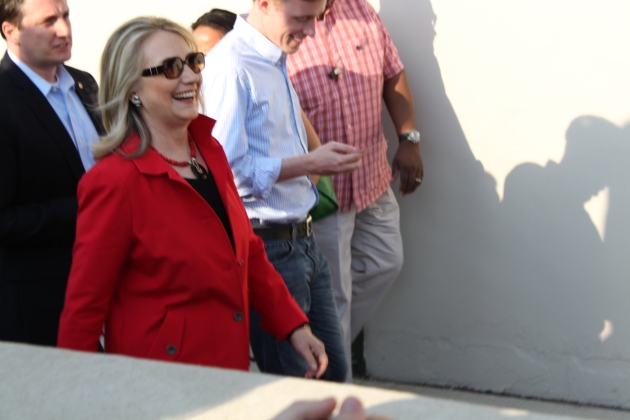NATO Summit: Clinton, NATO Dignitaries Appear at Wrigley
May 23, 2012 1 Comment

Secretary of State Hillary Clinton makes her way into Wrigley Field on Saturday night. (Photo by Sean McDonough)
By Sean McDonough
(Story originally posted May 18, 2012 on The Red Line Project)
The Red Line Project: Secretary of State Hillary Clinton was in attendance Saturday night as the Cubs hosted the White Sox in a rare weekend night game at Wrigley Field.
Clinton is in Chicago this weekend to attend the NATO summit, which officially begins Sunday with meetings that continue through Monday.
Clinton arrived via motorcade nearly 30 minutes before the game started and was accompanied by Illinois Gov. Pat Quinn, Senator Dick Durbin, Defense Secretary Leon Panetta, and General John Allen, the top U.S commander in Afghanistan, who threw out the game’s first pitch.
Clinton, a Park Ridge native and lifelong Cubs fan, waved and smiled at fans as she entered the ballpark through the Cubs executive offices entrance on the Southwest end of the field. Clinton proved her fandom by staying until the very end of the game despite her Cubs losing, 7-4.
As she departed, Clinton shook hands and exchanged words with groups of Cubs and White Sox fans.
With so many political powerhouses on hand, many thought that the Occupy protest groups would pay Wrigley Field a visit, but none showed.
But media outlets armed with cameras, hundreds of Chicago Police officers and the Secret Service did show. The police traveled in groups as they patrolled the perimeters of the ballpark. Even Garry McCarthy, superintendent of the Chicago Police Department, made a brief appearance to check in on his the officers.
Protesters weren’t the only thing lacking Saturday night. With the group of dignitaries in attendance, many expected Wrigley Field to feature tighter security, especially at the entrance gates. Instead, the Friendly Confines resembled its typical self as excited fans flowed smoothly through the gates to take in the ballgame on what was a beautiful, 80-degree evening.
Ticket collectors were not accompanied by extra security guards and there were no metal-detecting wands. Bags were searched, but that is common for MLB games.
The Cubs and the city announced on Thursday that several streets surrounding Wrigley Field would be closed as an added security precaution, but none were actually shut down except for parts of Waveland, Sheffield, and Addison, which are ordinarily closed to vehicles before, during and after Cubs games.
Police on hand were confused about which streets might be closed and what time they would be blockaded. Minutes before the start of the game, an officer admitted to an inquiring bystander that neither he nor his fellow officers had been notified about any street-closing strategy.
The relationship between fans and the police was civil and respectful. There were no clashes between the two, but one man was aggressively questioned by a group of police. The man insisted he was a reporter and that he was just doing his job. He produced what looked like proper credentials. Yet, he was thoroughly searched and taken away by the police for further questioning, only to be released minutes later and allowed to go about his business.
Few blamed the summit for causing travel pains on their way to the game.
Marty Grove, 49, was one of many who took a charter bus; Patrick Louie, 23, rode the red line; Steven and Shannan Bargle drove right into Wrigleyville. None of them expressed frustration about the summit for causing any travel inconveniences.
But on his way from Indiana to Chicago, 21-year-old Eric Fort said traffic from the summit caused an hour delay to his commute. As they spilled out of the ballpark, fans were in agreement that security precautions did not seem out of the ordinary and that Saturday’s game did not resemble anything other than a typical trip to Wrigley Field.
“It was nothing different than what we normally see at a normal Cubs game,” said Chris Quevedo, 27, a Streamwood resident.
“It felt pretty normal,” added Amanda Raddock, 21, of Chicago.


